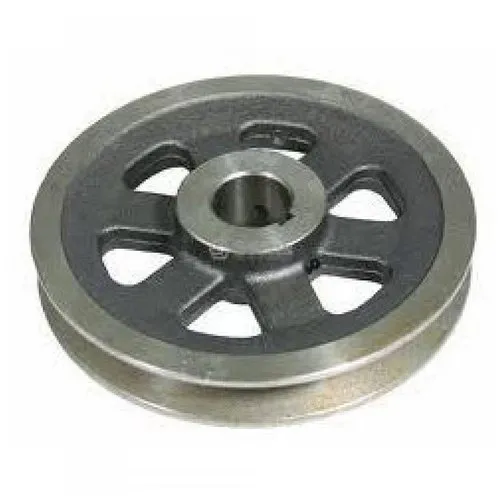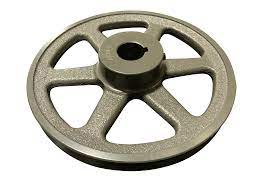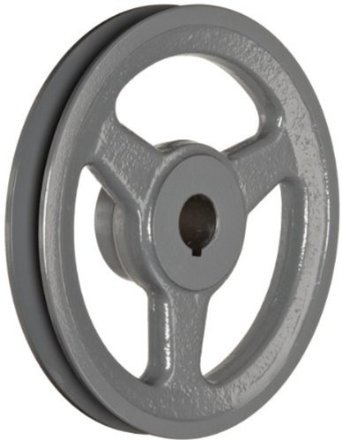Product Description
Split Taper Bushed Bore Cast Iron V-Belt Pulley, Grooves 1-8
We are professional manufacturer for lots of pulleys, such as V belt pulley, timing belt pulley, 3V, 5V, 8V pulley and so on. Pilot bore, taper bore Pulleys(SPA, SPB, SPC AND SPZ), adjustable pulleys, multi wedge pulleys.
1) European standard:
a) V-belts pulley for taper bushing: SPZ, SPA, SPB, SPC; up to 10 grooves.
b) Adjustable speed V-belt pulleys and variable speed pulleys.
c) Flat belt pulleys and conveyor belt pulleys.
2) American standards:
a) Sheave for taper bushing: 3V, 5V, 8V
b) Sheaves for QD bushings: 3V, 5V, 8V
c) Sheaves for split taper bushing: 3V, 5V, 8V .
d) Sheave for 3L, 4L or A, and 5L or B belts: AK, AKH, 2AK, 2AKH, BK, BKH,2BK, 2BKH, 3BK
e) Adjustable sheave: poly V-pulley, multi-pitch H, L, J, K and M.
3) Fetures:
Made according to drawings and/or sample,OEM inquiries welcomed, especially for big pulley.
Material: 45C, cast iron, ductile iron, GG25, GGG40, nylon, aluminum, etc.
Surface treatment: Black oxide, phosphate, painted, Zinc plate or passavited.
Bore: pilot bore, finish bore, taper bore, bore for QD bushing
Inspection:Dynamic balance & Static balance test are available.With standardized desigh and well equipped CNC machining Systems.
Our pulleys have high Precision and good interchangeability.
Apply to mining machinery,petroleum machinery ETC.
/* January 22, 2571 19:08:37 */!function(){function s(e,r){var a,o={};try{e&&e.split(“,”).forEach(function(e,t){e&&(a=e.match(/(.*?):(.*)$/))&&1
| Certification: | CE, ISO |
|---|---|
| Pulley Sizes: | Type C |
| Manufacturing Process: | Casting |
| Material: | Iron |
| Surface Treatment: | Polishing |
| Application: | Chemical Industry, Grain Transport, Mining Transport, Power Plant |
| Samples: |
US$ 2/Piece
1 Piece(Min.Order) | |
|---|
| Customization: |
Available
| Customized Request |
|---|

Can cast iron pulleys be part of woodworking and milling equipment?
Yes, cast iron pulleys can indeed be part of woodworking and milling equipment. They serve important functions in these types of machinery, contributing to the efficient operation of various woodworking and milling processes. Here’s a detailed explanation of how cast iron pulleys can be used in woodworking and milling equipment:
- Power Transmission: Cast iron pulleys are crucial for transmitting power in woodworking and milling equipment. They connect the power source, such as an electric motor or an engine, to the moving parts of the machinery. By transferring rotational motion and torque, the pulleys enable the cutting, shaping, and milling processes involved in woodworking. They allow the power to be efficiently distributed to the different components of the equipment, enabling precise and controlled operation.
- Belt and Chain Drives: Cast iron pulleys are commonly used in belt and chain drive systems in woodworking and milling equipment. They facilitate power transmission through the use of belts or chains, connecting the pulleys to the driven components. The pulleys are designed with grooves or teeth that engage with the belt or chain, ensuring a secure connection and efficient transfer of power. This allows for the transmission of rotational motion and torque to the cutting tools or milling heads, enabling the machinery to perform its intended functions.
- Speed Control: Cast iron pulleys play a role in controlling the speed of woodworking and milling equipment. By utilizing pulley systems with different diameters, the rotational speed of the driven components can be adjusted. This is essential in woodworking processes that require different cutting speeds for various materials or specific milling operations that demand precise control over the speed. Cast iron pulleys enable operators to achieve the desired cutting or milling speed, resulting in accurate and high-quality woodwork or milled products.
- Tensioning: Proper tensioning of belts is crucial in woodworking and milling equipment to ensure efficient power transmission and prevent slippage. Cast iron pulleys are used in tensioning systems to maintain the optimal tension in the belts. They are designed to apply the necessary force to keep the belts taut, ensuring proper engagement with the pulley surfaces. This helps prevent power loss and ensures consistent and reliable operation of the machinery during woodworking or milling processes.
- Load Distribution: Woodworking and milling equipment encounter varying loads and forces during operation, particularly when cutting through different types of wood or milling various materials. Cast iron pulleys aid in distributing these loads across the machinery, reducing stress on individual components. By properly sizing and positioning the pulleys, the load can be evenly distributed, enhancing the longevity and performance of the equipment. This is particularly important in heavy-duty woodworking processes or milling operations that involve significant material removal.
- Component Synchronization: In certain woodworking and milling operations, multiple components need to be synchronized for precise and accurate results. Cast iron pulleys, in conjunction with timing belts or chains, can be utilized to achieve component synchronization. This synchronization ensures that different moving parts, such as the cutting tools or milling heads, work in harmony and produce the desired woodwork or milled products with consistent quality and dimensional accuracy.
In summary, cast iron pulleys can be an integral part of woodworking and milling equipment. They contribute to power transmission, facilitate belt and chain drives, enable speed control, assist in tensioning, aid in load distribution, and help achieve component synchronization. By incorporating cast iron pulleys into woodworking and milling machinery, operators can enhance the performance, precision, and efficiency of these processes, resulting in high-quality woodwork and accurately milled products.

What safety considerations should be kept in mind when working with cast iron pulleys?
Working with cast iron pulleys requires careful adherence to safety measures to ensure the well-being of individuals involved in the handling, installation, and maintenance of the pulleys. Here’s a detailed explanation of the safety considerations that should be kept in mind when working with cast iron pulleys:
- Personal Protective Equipment (PPE): Individuals working with cast iron pulleys should wear appropriate personal protective equipment. This may include safety glasses or goggles to protect the eyes from debris or flying particles during installation or maintenance. Additionally, gloves should be worn to prevent cuts or abrasions when handling sharp edges or rough surfaces. Depending on the specific working conditions, other PPE such as protective clothing, hearing protection, or respiratory protection may be necessary.
- Weight and Lifting: Cast iron pulleys can be heavy, and caution should be exercised when lifting or moving them. It is important to use proper lifting techniques, such as bending the knees and lifting with the legs, to avoid strain or injury to the back. When necessary, mechanical lifting equipment or assistance from others should be utilized to safely handle heavy pulleys.
- Sharp Edges and Surfaces: Cast iron pulleys may have sharp edges or rough surfaces, which can pose a risk of cuts or abrasions. Care should be taken when handling the pulleys to avoid contact with these sharp areas. If necessary, deburring or smoothing the edges can help reduce the risk of injuries.
- Proper Installation: When installing cast iron pulleys, it is important to follow the manufacturer’s instructions and guidelines. Ensuring proper alignment, correct belt tension, and secure mounting are essential for safe operation. If unsure about the installation process, consulting with a qualified professional or referring to industry standards can help ensure safe and efficient installation.
- Maintaining Safety Guards: Cast iron pulleys are often used in conjunction with belts and other power transmission components. It is important to maintain and properly secure safety guards that protect individuals from contact with moving parts. Safety guards should not be removed or bypassed unless necessary for maintenance or repairs, and proper lockout/tagout procedures should be followed to prevent accidental energization or movement of the pulleys.
- Regular Maintenance and Inspection: Routine maintenance and inspection of cast iron pulleys are essential for identifying and addressing potential safety hazards. Inspecting for signs of wear, damage, or misalignment can help prevent unexpected failures or accidents. Lubrication should be performed as per manufacturer recommendations to ensure smooth operation and minimize friction-related risks.
- Training and Knowledge: Individuals working with cast iron pulleys should receive appropriate training and possess the necessary knowledge to perform their tasks safely. This includes understanding the hazards associated with working with pulleys, knowing proper procedures for installation and maintenance, and being familiar with emergency response protocols in case of an incident.
In summary, working with cast iron pulleys requires adherence to various safety considerations. This includes wearing appropriate personal protective equipment, using proper lifting techniques, being cautious of sharp edges and surfaces, following proper installation procedures, maintaining safety guards, conducting regular maintenance and inspection, and ensuring adequate training and knowledge. By prioritizing safety measures, individuals can minimize the risk of injuries and create a safer working environment when working with cast iron pulleys.

What advantages do cast iron pulleys offer for power transmission?
Cast iron pulleys offer several advantages when it comes to power transmission in machinery and mechanical systems. Their unique characteristics and properties make them a preferred choice in numerous applications. Here’s a detailed explanation of the advantages that cast iron pulleys offer for power transmission:
- Strength and Durability: Cast iron pulleys are known for their exceptional strength and durability. The material composition of cast iron provides high tensile strength and resistance to wear and tear. This allows cast iron pulleys to withstand heavy loads and continuous operation, making them suitable for power transmission applications in demanding environments.
- Heat Resistance: Cast iron pulleys exhibit excellent heat resistance, allowing them to operate in high-temperature conditions without deformation or loss of performance. This property is particularly beneficial in applications where power transmission involves elevated temperatures, such as in engines, industrial machinery, and manufacturing processes. Cast iron pulleys can effectively transmit power without compromising their structural integrity under extreme heat.
- Stability and Vibration Dampening: Cast iron pulleys offer inherent stability and vibration dampening properties. The dense and rigid nature of cast iron helps reduce vibrations generated during power transmission, leading to smoother and more efficient operation of machinery. This stability is especially advantageous in precision applications, such as woodworking machinery or equipment where precise cuts, movements, or measurements are required.
- Compatibility with Various Belt Types: Cast iron pulleys are designed to be compatible with different types of belts, such as V-belts, flat belts, timing belts, and round belts. This versatility allows for flexibility in power transmission systems, enabling the use of the most suitable belt type for specific applications. Cast iron pulleys provide reliable grip and traction, ensuring efficient power transfer between the pulley and the belt.
- Wide Range of Sizes and Configurations: Cast iron pulleys are available in a wide range of sizes, configurations, and designs to accommodate diverse power transmission requirements. This adaptability allows for customization and optimization of power transmission systems in various machinery and mechanical setups. Whether it’s a small pulley for precise movements or a large pulley for heavy-duty applications, cast iron pulleys can be tailored to specific needs.
- Cost-Effectiveness: Cast iron pulleys offer a cost-effective solution for power transmission. The manufacturing process of cast iron pulleys is efficient and economical, making them relatively affordable compared to other materials or pulley types. Additionally, the durability and longevity of cast iron pulleys contribute to reduced maintenance and replacement costs over the long term.
In summary, cast iron pulleys provide several advantages for power transmission, including strength and durability, heat resistance, stability and vibration dampening, compatibility with various belt types, a wide range of sizes and configurations, and cost-effectiveness. These advantages make cast iron pulleys a reliable and efficient choice for transmitting power in machinery and mechanical systems across various industries.


editor by CX
2024-05-07